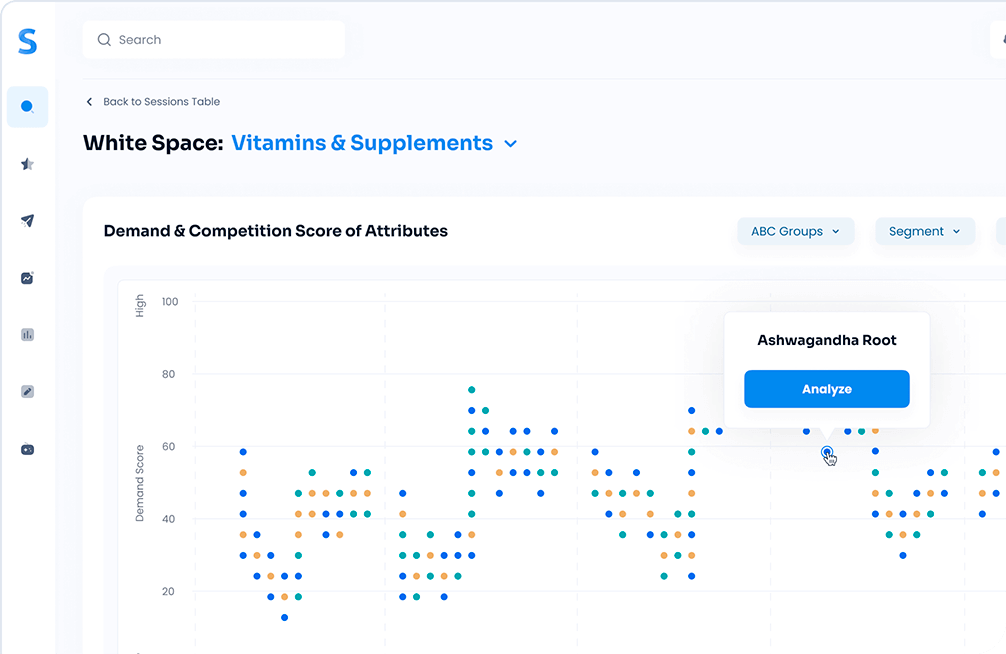While it’s obviously important to stay on top of which sensory attributes are most important for your household care product lineup, it’s equally important to keep an eye on what your consumers are uninterested in. Why? You can avoid making a critical error in your product R&D by simply avoiding these sensory attributes in your household care products.
We took a hard look into which sensory attributes for household care products are the least buzzworthy or popular with consumers in 2023. We’ve analyzed 71 household care sensory attributes using our White Space AI tool to determine which ones to stay away from if you want to prevent a dud product launch. You’ll find our predictions for losing household care sensory attributes for 2023 below.
Durable

Durable (0.21 percent share of voice) takes the number one spot on our predicted loser’s list with a predicted negative 29.80 perfect year-over-year growth rate. While consumers will still want their household cleaning products to be durable, they won’t be using that term to describe their favorite cleaning products.
With competition growing fiercer each year, durability is now table stakes – consumers simply expect it. So, we’re not surprised to see this sensory attribute his our loser’s list for 2023. While durable products fill many consumer needs, durable products don’t translate well to social media. Consumers will want to be wowed by a product’s before-and-after cleaning capabilities, not necessarily how long something stayed clean after the fact.
Non-scratch

Products labeled specifically as Non-scratch (0.04 percent share of voice) have a lower negative 7.35 percent growth outlook for next year. While this sensory attribute might have performed well in previous years, it will not be trending in 2023. This could be due to various factors, but our team predicts it has to do with the increasing availability of scratch-resistant materials for floors, countertops, appliances, and so forth. Consumers may simply have less of a need than ever before for Non-scratch products like these Scotch-Brite® Advanced Scrub Dots Antibacterial Non-Scratch Scrubbers.
Shine

The team here at Simporter forecasts a low growth potential for Shine household care products. Shine has been used to describe household care products for decades — its 2.64 percent share of voice is a testament to its influence over consumer spending. Everybody loves a house that Shines, but consumers are shying away from it ever so slightly as far as sensory attributes are concerned. We anticipate a negative growth rate of 6.17 percent for Shine next year, so while that’s not a massive dropoff in popularity, you’ll still want to make sure your brand isn’t falling behind on the terminology consumers use and engage with online.
Instead of Shine, consumers will be using terms like Sparkling and Bright when talking about their go-to cleaning products. For more insights on what sensory attributes will be trending in 2023, make sure to check out our blog here.
Dry

Our AI models forecast slow growth for Dry household care products (-4.22 percent growth rate). With so much time spent at home the past two years, houses saw more traffic than usual. More people and pets mean dirtier houses and tougher messes. So, consumers who occasionally dry mopped their floors pre-pandemic will be using heavier duty mops that leave their floors sparkly clean. Companies like Swiffer offer Dry and Wet mop attachments for their products, so we’d recommend spending more resources on developing options that shy away from anything with Dry (1.67 percent share of voice) as a predominant description.
On the other hand, consumers aren’t as focused on how quickly or effectively a product dries. Again, the focus will be on how the product performs at the moment of use. Viral cleaning videos and youtube tutorials want to wow audiences with how effective products clean up everyday messes, not highlight the drying process.
Consumer Sensory Shifts
Households have seen a lot during the pandemic. As consumers adopt pre-pandemic routines and change the amount of time they’re spending at home, they will also be adjusting their household care routines. Previously popular sensory attributes like Durable and Non-Scratch will lose favor to interactive features like bubbly and foaming products.
As we discussed in our predicted winner’s blog here, it won’t just be about how your product looks, feels, and smells in real life, but how well those sensory attributes communicate via social media.
Need More Insights on Sensory Attributes?
Every week, we produce content like this on our blog to provide our readers with data-driven insights for their R&D strategies. If you haven’t been keeping up with our blog and company updates, now’s a great time to take a peek at our recent content. Companies that work with Simporter see an uptick in their branding effectiveness — reach out today!
For more insights on home and fabric care trends, check out our recent webinar here. If you’re ready to see Simporter AI in action and learn what it can do for you, request a demo on our website.









